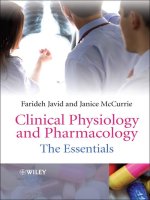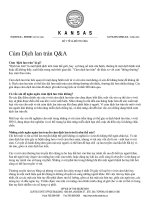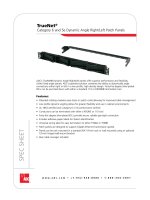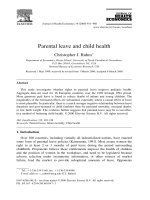Tài liệu Plain language and patient education: A summary of current research pptx
Bạn đang xem bản rút gọn của tài liệu. Xem và tải ngay bản đầy đủ của tài liệu tại đây (256.85 KB, 4 trang )
This is the first in a series
of briefs that focus on
evaluative research into
the use of alternative means
of health communication;
they include plain language,
audiotapes, videotapes,
interactive media, and
visual images. Searches
of the medical and education
literatures were conducted as
part of a Health Literacy
Project that is examining
the communication needs of
patients with limited literacy
or other communication barriers.
The guiding question for these
searches was: ‘What impacts
have been documented in
relation to the identified
target groups?’
The Health Literacy Project is a
joint initiative of The Centre
for Literacy of Quebec and
the Nursing Department of
the McGill University
Health Centre (MUHC).
Introduction
While health education
increasingly relies on print
materials, little has been done to
ensure that patients can actually
understand the information.
Relatively little research has
examined how health care
professionals can provide
important health care information
to patients with limited literacy or
other communication barriers.
Research has focussed on:
• how participants receive and
understand the information;
• how information and forms can
be simplified to improve
readability;
• the gap between readability
and comprehension; and
• other factors that affect
patients’ use or disregard
of print materials.
The issue of readability is
particularly crucial when
considering consent forms.
Methodology
This paper reviews 25 research
articles and one abstract published
in medical and education
literatures on the subject of
readability and patient
understanding. Databases
consulted in this search included:
Aidsline, CancerLit, ERIC,
Medline, PubMed. The studies
included in this brief measure the
effects of various facets of
“readability” and
“understandability,” such as
simplified messages, lowered
reading levels, writing style, the
use of illustrated text and clear
design concepts. A search for
studies that measured the effects of
easy-to-read health information on
health status yielded no results.
Who was included?
Of the research we reviewed, most
focussed on making health
materials more readable for the
general public. The majority of the
studies included people who had
completed at least nine years of
schooling. While several studies
acknowledged the correlation
among poverty, lower levels of
education and risk of poor health,
only five looked specifically at
patients with low reading abilities
(Bell, Davis 1996, 1998a,1998b,
Michielutte). Most of the studies
explicitly excluded people who did
not read and write English.
Few researchers consciously
studied ethnically or economically
diverse populations. One American
study discovered that while there
was no difference in comprehension
between ethnic groups, white
participants were more likely to
read print materials than African
Americans (Dowe).
Findings
The question most studies tried to
answer was “What can we change
about this material, manual or
form so that the average person
Plain language and patient education:
A summary of current research
The Centre for Literacy
Research Briefs on
Health Communications
No. 1
The Centre for Literacy • Research Briefs on Health Communications
can read it more easily?” Researchers
were startled to discover a great discrepancy between
levels of education and reading level. In many cases,
people were unable to understand materials which
health professionals believed they “should” have been
able to read. This raises questions about the ways in
which patients interact with print, how materials can be
made more readable, and other factors which could
affect how patients interact with print. The results show
that although some changes can make print materials
more understandable, health professionals must also
find other means of communicating with patients.
How do patients receive and understand
information?
Given the choice, patients prefer clear materials with
some illustrations (Bernardini, Bjorn, Cardinal, Davis
1996). Improving the layout and look of materials can
have an impact on how participants react to them. In
one study, patients trusted therapists who used clear
consent forms more than therapists with unclear
forms; they believed that the clear forms were more
relevant, even though the two forms included
essentially the same information (Wagner).
In several studies, texts with illustrations emphasizing
key points were better received than solid text
(Michielutta, Moll). One study, which has yet to
report its findings, posited that culturally-specific
material was essential (Pardini) while another showed
that patients preferred materials with culturally-
sensitive illustrations (Davis 1998a). Some studies
acknowledged that many patients simply do not use
print as their preferred method to access information
(Davis 1998a, Husted).
How can information and forms
be made more readable?
Many researchers understood the principles of clear
language that should have made health education
materials easier to understand. They revised materials
by breaking up longer sentences, substituting lay
language for professional jargon, using point form,
illustrations and white space, and lowering
reading levels.
Most studies found that the ideal reading level for
print materials was Grade 5 on the Flesch-Kincaid
scale (Meade). However, even if a document was
technically more readable, people did not necessarily
understand more. Several studies found that the print
material alone was not enough to ensure that patients
were able to read, understand and remember
information (Butow, Cardinal, Davis 1998a,
Drossaert, Estey 1994, Tymchuk).
Why are “readable” materials not understood?
Several studies noted that people with higher levels of
education were more likely to understand print
materials than people with less education. However,
lowering the reading level of a text from, for example,
grade 11 to grade 5 did not guarantee that people
with grade 12 or even a year of university would
understand the information (Cardinal). Several
studies sought to understand why materials were so
difficult to understand.
They concluded that:
• research is an artificial environment, which could
affect how much attention patients give to the task
of reading (Bjorn);
• materials which are more readable according to
technical measures, such as readability formulas,
may still use unfamiliar syntax, vocabulary or
points of reference (Estey 1994, Reid);
• patients who need information may be affected by
physical factors such as pain or discomfort, or stress
caused by illness (Estey 1993); and
• there are significant differences between what
patients want to know and what health
professionals think they should know
(Reid, Davis 1998a).
What factors affect patients’ use
or disregard of print materials?
A few studies noted that people understand and
remember what is important to them, yet the kinds of
information that health professionals believe is
important is not the same as the knowledge sought by
patients (Reid). Most health education materials are
developed with little regard for issues patients feel are
important. An American study noted that patient
education materials designed for low income, low
literate minority women did not include information
about cost, while cost was their most pressing question
[ 2 • Plain language and patient education ]
THE CENTRE FOR LITERACY
Research Briefs on
Health Communications
Writer: Tannis Atkinson
Editor: Staff of The Centre for Literacy
Primary researcher: Leanne Bowler
Additional research: Vanessa Spyropoulos
Publisher: The Centre for Literacy, 2003
Thanks to the National Literacy Secretariat, Human
Resources Development Canada (HRDC) for funding
this publication.
ISBN: 0-9734295-1-8
ISBN [SERIES]: 0-9734295-0-X
The Centre for Literacy • Research Briefs on Health Communications
The Centre for Literacy • Research Briefs on Health Communications
(Davis 1998a). In another study, physicians and
patients were asked to underline the twenty most
important points in the same leaflet. Physicians chose
passages which described physiopathology, while
patients indicated treatments and prognosis. From this,
the study concluded that the most useful materials
begin with what patients know and have questions
about, rather than with what health professionals feel
people should know (Reid).
Local context may be more important than technical
elements of the text. A study of cancer patients in
Australia (Butow), asked participants to examine five
chemotherapy booklets and choose the most relevant
and informative. Patients uniformly chose the booklet
that reflected none of the principles of clear language.
It had no illustrations or photographs and was written
in a narrative format. The main difference between
this booklet and the others was that it was produced
by a local cancer society. Others were written by
health care facilities or the national cancer association.
Changes to print materials alone cannot address larger
issues which more directly affected patients’
experiences. A Dutch study examined whether a clear
pamphlet about mammography would encourage
women to return for follow-up tests after their initial
breast screening. Although women read the clear
pamphlet more thoroughly than the more complex
version, they did not return because the procedure
was painful and their interactions with staff were not
pleasant. Researchers concluded that the leaflet was
“too weak an intervention” to influence women’s
decision to return (Drossaert). The research showed
that it does not matter how print materials are written
if other factors are barriers to health care.
Looking ahead
Print materials alone do not help most people
understand and remember the content. Some people
do not and never will rely on print materials. In light
of this, health professionals need to find other ways to
provide patients with health information.
Several researchers suggested that effective
interventions would include more face-to-face
interactions with patients, greater use of alternative
media (including audio-visual materials) and
opportunities for patients to discuss information with
health care professionals and other patients. Future
research could measure the effectiveness of:
• increasing the amount of time health professionals
spend with patients (Tymchuk, Reid)
• supplementing print materials with presentations,
instructions, group discussions and video materials
(Davis 1996, Reid, Taub, Young);
• training members of specific communities
to do outreach and patient education within their
community, and to develop culturally-specific
materials (Pardini).
Key Findings
• Medical research has not explicitly considered the
impact of plain language materials on people with
limited literacy.
• Many people cannot understand print materials
alone. More interaction with patients is essential.
Alternative media may help get the message across.
• Materials should address patients’ concerns
and questions. Materials based on what health
professionals believe patients “should” know are
less likely to be understood than materials
developed in the community or with patients.
When developing print materials…
• Readability formulas help, but are not enough.
Good writing requires excellent organization, clear
headings, and an engaging style.
• Rhetorical devices such as repetition, questions,
and concrete examples can help people absorb and
remember information.
• Materials should aim for a Grade 5 reading level
on the Flesch-Kincaid scale. However, readability
formulas cannot predict whether patients will
understand the material.
• Illustrations and headings can help, but colours can
distract or become an additional code that people
need to learn to “read.”
• Materials should be developed in collaboration with
target populations.
[ Plain language and patient education • 3 ]
The Centre for Literacy • Research Briefs on Health Communications
Limitations
The literature search for this review was limited to
medical and education databases. Only studies with
an evaluation component were included. Articles
that only described projects were eliminated.
Literature on plain language in the communications
and legal fields which were not reviewed for this
brief could provide some insight into applications
in health.
[ 4 • Plain language and patient education ]
References
Articles reviewed:
Bernardini, C., Ambrogi, V., Fardella, G., Perioli, L., &
Grandolini, G. (2001). How to improve the readability of the
patient package leaflet: A survey on the use of colour, print size,
and layout. Pharmacological Research, 43(5), 437-444.
Bjorn, B., Rossel, P., & Holm, S. (1999). Can the written
information to research subjects be improved? An empirical study.
Journal of Medical Ethics, 25 (3), 263-267.
Boyd, M.D., Graham, B.A., Gleit, C.J., & Whitman, N.I. (1998).
Health teaching in nursing practice: A professional model. Upper
Saddle River, NJ: Appleton & Lange.
Butow, P., Brindle, E., McConnell, D., Boakes, R., & Tattersall,
M. (1998). Information booklets about cancer: Factors influencing
patient satisfaction and utilization. Patient Education and
Counseling, 33 (2), 129-141.
Cardinal, B.J. (2000). (Un)informed consent in exercise and sport
science research? A comparison of forms written for two reading
levels. Research Quarterly for Exercise and Sport, 71 (3),
295-301.
Davis, T.C., Bocchini, J.A., Fredrickson, D., Arnold, C., Mayeaux,
E.J., Murphy, P.W., Jackson, R.H., Hanna, N. & Paterson, M.
(1996). Parent comprehension of polio vaccine information
pamphlets. Pediatrics, 97 (6 Pt 1), 804-810.
Davis, T.C., Fredrickson, D.D., Arnold, C., Murphy, P.W., Herbst,
M., & Bocchini, J.A. (1998a). A polio immunization pamphlet
with increased appeal and simplified language does not improve
comprehension to an acceptable level. Patient Education and
Counselling, 33 (1), 25-37.
Davis, T.C., Holcombe, R.F., Berkel, H.J., Pramanik, S., &
Divers, S.G. (1998b). Informed consent for clinical trials:
A comparative study of standard versus simplified forms. Journal
of the National Cancer Institute, 90 (9), 668-674.
Decker, K.M., & Harrison, M. (2002). Evaluating information for
women referred for breast screening abnormalities. Journal of
Cancer Education, 17 (1), 28-32.
Dowe, M.C., Lawrence, P.A., Carlson, J., & Keyserling, T.C.
(1997). Patients’ use of health-teaching materials at three
readability levels. Applied Nursing Research, 10 (2), 86-93.
Drossaert, C.H., Boer, H., & Seydel, E.R. (1996). Health
education to improve repeat participation in the Dutch
breast cancer screening programme: Evaluation of a leaflet
tailored to previous participants. Patient Education and
Counseling, 28 (2), 121-131.
Estey, A., Kemp, M., Allison, S., & Lamb, C. (1993). Evaluation
of a patient information booklet. Journal of Nursing Staff
Development, 9 (6), 278-282.
Estey, A., Musseau, A., & Keehn, L. (1994). Patient’s
understanding of health information: A multihospital approach.
Patient Education and Counseling, 24 (1), 73-78.
Garden, A.L., Merry, A.F., Holland, R.L., & Petrie, K.J. (1996).
Anaesthesia information: What patients want to know.
Anaesthesia and Intensive Care, 24 (5), 594-598.
Husted, G.L., Miller, M.C., & Brown, B. (1999). Test of an
educational brochure on advance directives designed for
well-elderly people. Journal of Gerontological Nursing,
25 (1), 34- 40.
Kaufer, D.S., Steinberg, E.R., & Toney, S.D. (1983). Revising
medical consent forms: An empirical model and test. Law,
Medicine, and Health Care, 11 (4), 155-162.
Lambert, C. (1998). Removing the mystery: Evaluation of a
parent manual by adolescent parents. Adolescence,
33 (129), 61-72.
Meade, C.D., Byrd, J.C., & Lee, M. (1989). Improving patient
comprehension of literature on smoking. American Journal of
Public Health, 79 (10), 1411-1412.
Michielutte, R., Bahnson, J., Digman, M.B., & Schroeder, E.M.
(1992). The use of illustration and narrative style to improve
readability of a health education brochure. Journal of Cancer
Education, 7 (3), 251-260.
Moll, J.M. (1986). Doctor-patient communication in
rheumatology: Studies of visual and verbal perception using
educational booklets and other graphic material. Annals of the
Rheumatic Diseases, 45 (3), 198-209.
Pardini, R.S. (1996). Effect of educational brochure on Cherokee
women with abnormal pap smears. Public Health Reports, 111
(6), 546-547.
Peterson, D.L., Murphy, D.E., Jaffe, D.M., Richardson, M.S.,
Fisher, E.B., Shannon, W., Sussman, L., & Strunk, R.C. (1999).
A tool to organize instructions at discharge after treatment of
asthamatic children in an emergency department. Journal of
Asthma 36(7), 597-603.
Reid, J.C., Klachko, D.M., Kardash, C.A.M., Robinson, R.D.,
Scholes, R., & Howard, D. (1995).Why people don’t learn from
diabetes literature: Influence of text and reader characteristics.
Patient Education and Counseling, 25 (1), 31-38.
Taub, H.A. (1980). Informed consent, memory, and age.
The Gerontologist, 20 (6), 686-690.
Wagner, L., Davis, S., & Handelsman, M.M. (1998). In search of
the abominable consent form: The impact of readability and
personalization. Journal of Clinical Psychology, 54 (1), 115-120.
Abstract reviewed:
Bell, J.H., & Johnson, R.E. (1992). Effect of lowering the
reading level of a health education pamphlet on increasing
comprehension by ESL adults. Calgary, AB: Research and
Development Committee, Calgary General Hospital.
The Centre for Literacy • Research Briefs on Health Communications









